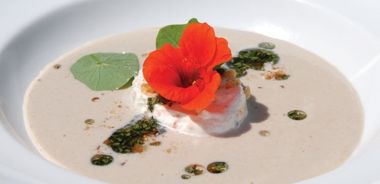Wild Chanterelle Mushroom, Walnut and Summer Savoury Soup with Nasturtium Flower Cream

Chanterelles provide a wonderful earthiness to the flavour of this soup, but feel free to experiment with other exotic varieties. The key is freshness.
1/2 cup (125 mL) unsalted butter
2 cups (500 mL) wild chanterelle mushrooms, brushed and chopped
1/2 cup (125 mL) walnuts, shelled
1 cup onion, diced
1/2 cup (125 mL) carrot, diced
1/4 cup (60 mL) celery, diced
20 fennel seeds
10 coriander seeds
10 cumin seeds
2 Tbsp (30 mL) garlic, chopped
2 Tbsp (30 mL) ginger, peeled and minced
1/2 cup (125 mL) dry white wine
5 cups (1.25 L) chicken stock
1 cup (250 mL) whipping (heavy) cream
2 fresh or dried bay leaves
2 Tbsp (30 mL) fresh summer savoury leaves, removed from stem
Garnish
1/2 cup (125 mL) organic nasturtium flowers, chopped, stems removed
1/2 cup (125 mL) whipping cream
Place butter in large stainless steel, noncorrosive pot over medium heat. Once butter has melted, add mushrooms, walnuts, onion, carrot, celery, fennel, coriander, and cumin seeds, and saute until onions are translucent and carrots begin to soften (about 10 to 13 minutes).
Add garlic and ginger, and saute for 5 minutes. Stir constantly to avoid burning. Add white wine and increase heat to high. Reduce wine until approximately 1/4 cup (60 mL) remains. Add stock, cream, and bay leaves, and bring to boil. Then, reduce heat to medium and simmer for 25 minutes. Remove from heat; remove and discard bay leaves.
While soup cools, prepare garnish. Place whipping cream and nasturtium flowers in medium-sized bowl and whip until stiff peaks form. (Using only yellow nasturtium flowers will give a nice contrast to the soup.)
Once soup has cooled for 30 minutes, pure in blender at high speed in small batches for 2 minutes each, or until very smooth. Return puree'd soup to pot. Bring to boil and serve. Ladle soup into bowls and garnish each with a dollop of whipped nasturtium cream. Serves 6.
source: "Sooke Harbour House", alive #311, September 2008




